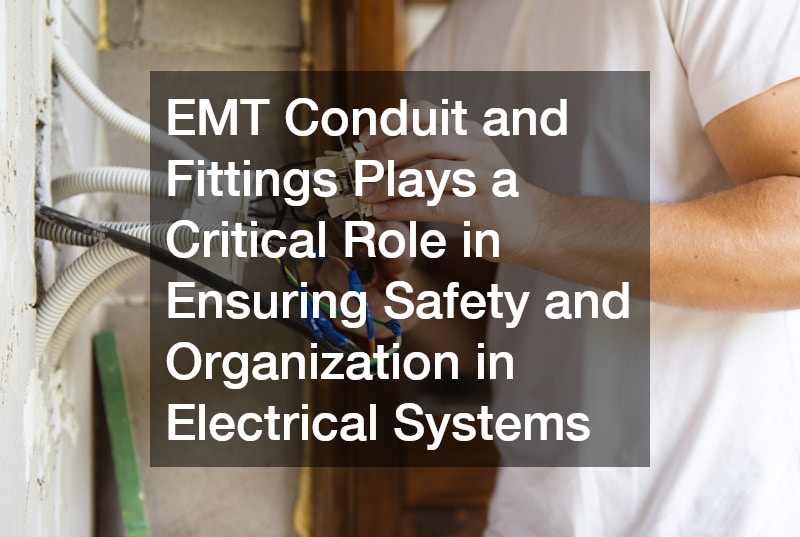EMT conduit, or Electrical Metallic Tubing, is a type of thin-walled, steel tubing used in electrical installations. Unlike rigid conduit, EMT is easier to bend, making it flexible for various installation needs. The steel composition offers solid protection for electrical wires against mechanical damage. Due to its material properties, the EMT conduit is often preferred in commercial and industrial applications. Its lightweight nature also makes it a favorable choice for many contractors.
The use of EMT conduit and fittings plays a critical role in ensuring safety and organization in electrical systems. Properly installed, EMT conduits help prevent short circuits and electrical fires by providing a secure pathway for cables. Additionally, it offers valuable support and organization in complex wiring systems. The conduit is usually connected with appropriate fittings to ensure system integrity and safety. Working with EMT requires an understanding of its specifications and compliance with electrical codes.
EMT conduit is typically made using galvanized steel to resist corrosion and offer longevity. This resilience ensures that the tubing can withstand environmental factors, which are crucial for outdoor applications. Installation of EMT conduit generally requires specific tools, such as a pipe bender, to achieve the required angles without damaging the tubing. Compliance with the National Electrical Code (NEC) is essential when working with EMT to prevent legal and safety issues. Aspects like grounding and bonding must be appropriately addressed in all EMT installations.
Understanding EMT Fittings
EMT fittings are essential components that connect or terminate sections of EMT conduit. They come in various types, including couplings, connectors, and straps, each serving a specific purpose in the installation process. Couplings, for instance, are used to join two lengths of EMT, ensuring continuity and securing the pathway for electrical conductors. Proper selection and installation of fittings help maintain the system’s efficiency and safety. Fittings must be compatible with the conduit size to ensure a secure and proper connection.
The material of the fittings often matches that of the EMT conduit, usually zinc-plated or galvanized steel. This consistency in material helps maintain corrosion resistance throughout the electrical system. Installing the right fittings requires an understanding of the job’s specific requirements, such as the environment and load considerations. For example, in damp locations, compression fittings may be preferable to ensure a watertight seal. The functionality of the entire EMT system heavily relies on the correct application of these fittings.
Another critical aspect of EMT fittings is grounding and bonding, which are fundamental to electrical safety. Bonding ensures that all metal parts are electrically connected, reducing the risk of electric shock. Grounding provides a path for fault current to return to the earth, preventing damage or fire in case of system failure. EMT fittings often have provisions for bonding through them, which must be effectively utilized to comply with safety standards. Ensuring the entire system is properly grounded and bonded is crucial in averting potential hazards.
Comparisons and Considerations
When choosing between EMT and other conduit types like PVC or rigid metal conduit (RMC), several factors come into play. EMT conduit is notably lighter and easier to handle than RMC, which can significantly expedite installation time. However, it is not as robust as RMC, meaning it’s not suitable for environments where physical protection is paramount. Compared to PVC, EMT is non-combustible and offers better electrical grounding. Choosing the right conduit often depends on the specific demands of the project, including environment, budget, and desired installation speed.
Cost-effectiveness is another factor that favors EMT, given that it typically costs less than RMC. This makes it a preferred choice for projects where budget constraints are a significant concern without compromising safety and durability. Nevertheless, for environments that demand high resistance to physical damage, the extra expense of RMC may be justified. Proper evaluation of the site conditions and future maintenance needs can significantly influence conduit selection. Balancing cost with functionality and compliance ensures a successful installation.
Environmental and aesthetic considerations can also impact the choice of conduit. EMT is often favored for indoor installations where its metallic appearance can either blend in or complement modern industrial design elements. In contrast, its application in outdoor settings might require additional measures such as painting to prevent rust and enhance durability. A comprehensive assessment should consider both the functional requirements and the visual impact of the installation. Effective planning and understanding of the EMT conduit and fittings are vital for achieving the best outcomes in electrical installations.
Understanding EMT conduit and fittings is essential for anyone involved in electrical installations, from professional electricians to DIY enthusiasts. This system offers an effective means of protecting and organizing electrical wiring, vital for both safety and functionality. The lightweight, flexible nature of EMT, combined with the robust protection it provides, makes it a popular choice in many scenarios. Proper installation and maintenance are crucial to ensuring a safe and efficient electrical system. In-depth knowledge of fittings, grounding, and the material’s characteristics can greatly influence the system’s success.
Adhering to safety codes and regulations is non-negotiable for any electrical installation involving EMT conduit and fittings. Balancing cost-effectiveness, environmental resistance, and compliance creates a well-rounded approach to conduit selection. The nuances of selector configuration and specific application environments must be carefully considered. By mastering these elements, one can ensure that the electrical system is reliable, efficient, and safely enclosed within its EMT framework. Continuous education in electrical standards and technological advancements can aid in optimal decision-making.
As the electrical industry evolves, innovations in materials and installation techniques expand the possibilities for EMT conduit applications. These advancements support the need for higher safety standards, energy efficiency, and sustainable practices. Staying informed about these developments is essential for professionals seeking to offer cutting-edge solutions. Clear understanding and application of the basics of EMT conduit and fittings can significantly contribute to successful electrical projects. Whether planning a new installation or upgrading an existing one, the foundational knowledge of EMT systems is invaluable.


